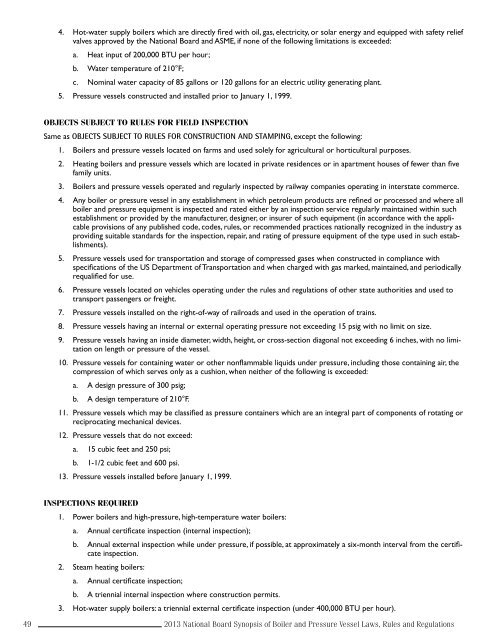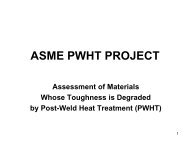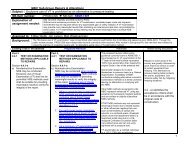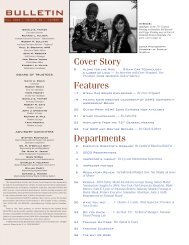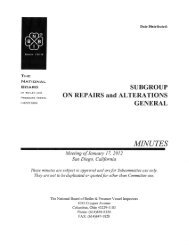Laws, Rules and Regulations - The National Board of Boiler and ...
Laws, Rules and Regulations - The National Board of Boiler and ...
Laws, Rules and Regulations - The National Board of Boiler and ...
Create successful ePaper yourself
Turn your PDF publications into a flip-book with our unique Google optimized e-Paper software.
49<br />
4. Hot-water supply boilers which are directly fired with oil, gas, electricity, or solar energy <strong>and</strong> equipped with safety relief<br />
valves approved by the <strong>National</strong> <strong>Board</strong> <strong>and</strong> ASME, if none <strong>of</strong> the following limitations is exceeded:<br />
a. Heat input <strong>of</strong> 200,000 BTU per hour;<br />
b. Water temperature <strong>of</strong> 210°F;<br />
c. Nominal water capacity <strong>of</strong> 85 gallons or 120 gallons for an electric utility generating plant.<br />
5. Pressure vessels constructed <strong>and</strong> installed prior to January 1, 1999.<br />
ObJeCtS SUbJeCt tO rUleS FOr FIelD InSpeCtIOn<br />
Same as OBJECTS SUBJECT TO RULES FOR CONSTRUCTION AND STAMPING, except the following:<br />
1. <strong>Boiler</strong>s <strong>and</strong> pressure vessels located on farms <strong>and</strong> used solely for agricultural or horticultural purposes.<br />
2. Heating boilers <strong>and</strong> pressure vessels which are located in private residences or in apartment houses <strong>of</strong> fewer than five<br />
family units.<br />
3. <strong>Boiler</strong>s <strong>and</strong> pressure vessels operated <strong>and</strong> regularly inspected by railway companies operating in interstate commerce.<br />
4. Any boiler or pressure vessel in any establishment in which petroleum products are refined or processed <strong>and</strong> where all<br />
boiler <strong>and</strong> pressure equipment is inspected <strong>and</strong> rated either by an inspection service regularly maintained within such<br />
establishment or provided by the manufacturer, designer, or insurer <strong>of</strong> such equipment (in accordance with the applicable<br />
provisions <strong>of</strong> any published code, codes, rules, or recommended practices nationally recognized in the industry as<br />
providing suitable st<strong>and</strong>ards for the inspection, repair, <strong>and</strong> rating <strong>of</strong> pressure equipment <strong>of</strong> the type used in such establishments).<br />
5. Pressure vessels used for transportation <strong>and</strong> storage <strong>of</strong> compressed gases when constructed in compliance with<br />
specifications <strong>of</strong> the US Department <strong>of</strong> Transportation <strong>and</strong> when charged with gas marked, maintained, <strong>and</strong> periodically<br />
requalified for use.<br />
6. Pressure vessels located on vehicles operating under the rules <strong>and</strong> regulations <strong>of</strong> other state authorities <strong>and</strong> used to<br />
transport passengers or freight.<br />
7. Pressure vessels installed on the right-<strong>of</strong>-way <strong>of</strong> railroads <strong>and</strong> used in the operation <strong>of</strong> trains.<br />
8. Pressure vessels having an internal or external operating pressure not exceeding 15 psig with no limit on size.<br />
9. Pressure vessels having an inside diameter, width, height, or cross-section diagonal not exceeding 6 inches, with no limitation<br />
on length or pressure <strong>of</strong> the vessel.<br />
10. Pressure vessels for containing water or other nonflammable liquids under pressure, including those containing air, the<br />
compression <strong>of</strong> which serves only as a cushion, when neither <strong>of</strong> the following is exceeded:<br />
a. A design pressure <strong>of</strong> 300 psig;<br />
b. A design temperature <strong>of</strong> 210°F.<br />
11. Pressure vessels which may be classified as pressure containers which are an integral part <strong>of</strong> components <strong>of</strong> rotating or<br />
reciprocating mechanical devices.<br />
12. Pressure vessels that do not exceed:<br />
a. 15 cubic feet <strong>and</strong> 250 psi;<br />
b. 1-1/2 cubic feet <strong>and</strong> 600 psi.<br />
13. Pressure vessels installed before January 1, 1999.<br />
InSpeCtIOnS reQUIreD<br />
1. Power boilers <strong>and</strong> high-pressure, high-temperature water boilers:<br />
a. Annual certificate inspection (internal inspection);<br />
b. Annual external inspection while under pressure, if possible, at approximately a six-month interval from the certificate<br />
inspection.<br />
2. Steam heating boilers:<br />
a. Annual certificate inspection;<br />
b. A triennial internal inspection where construction permits.<br />
3. Hot-water supply boilers: a triennial external certificate inspection (under 400,000 BTU per hour).<br />
2013 <strong>National</strong> <strong>Board</strong> Synopsis <strong>of</strong> <strong>Boiler</strong> <strong>and</strong> Pressure Vessel <strong>Laws</strong>, <strong>Rules</strong> <strong>and</strong> <strong>Regulations</strong>


